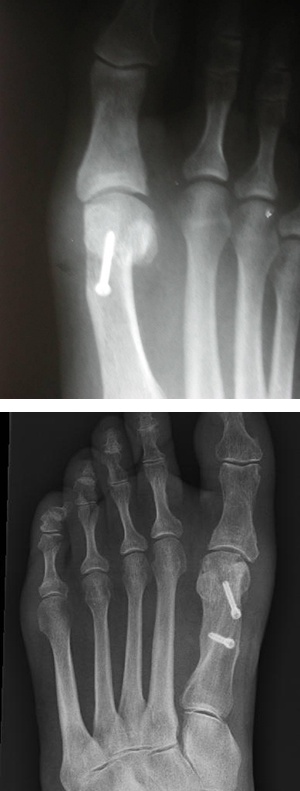- 1300 478 375
Hallux valgus, often referred to as “a bunion”, is a deformity of the big toe.
The toe tilts over towards the smaller toes and a bony lump appears on the inside of the foot. Sometimes a soft fluid swelling develops over the bony lump.
The bony lump is the end of the “knuckle-bone” of the big toe (the first metatarsal bone) which becomes exposed as the toe tilts out of place.
The procedure involves
Generally, two different types of first metatarsal cuts can be made:

The operation is usuallydone under general anaesthetic (asleep). Alternatively, an injection in the back, leg or around the ankle can be done to make the foot numb while the patient remains awake. Local anaesthetic injections do not always work and in that case you may have to go to sleep if the operation is to be done. Your anaesthetist will advise you about the best choice of anaesthetic for you.
In addition, local anaesthetic will be injected into your leg or foot while you are asleep to reduce the pain after the operation even if you go to sleep for the surgery. You will also be given pain-killing tablets as required.
Usually dressings and a bandage will be put on your foot and you can walk on it in a protective sandal with a stiff sole straight after the surgery.
You can put as much weight as comfortable through this, preferably through the heel. When one foot is operated on and once you are comfortable you are discharged from hospital on the same day. When both feet are operated on, or other surgery is performed, usually you are asked to stay in hospital for 1-2 days.
It is very important that the leg remains elevated most of the time in the first 2 weeks – rest is important. Do not wet or remove the dressings.
SWELLING – this can be minimised by elevating your foot above your heart; icing the foot may be helpful
PAIN – You will receive a prescription for pain medication on discharge from hospital. Pain can also be minimised by elevating your leg.
BLEEDING – This always occurs. You may notice some oozing through the bandages.
You will be seen in Dr Sterling’s rooms 12-14 days after your operation. An x-ray of your foot will be taken. The dressings will be removed and the wounds inspected. You will be shown how to exercise your toe, look after your wound, and how to splint your toe to stop it bending back against the smaller toes. You should continue heel weight-bearing for a further 4 weeks.
You will be seen again at 6 weeks after the surgery. An x-ray will be performed. If this shows that the bone is healed, you will be permitted to walk without any splint. A further appointment will be made 6 weeks later.
Normally you can walk on the foot immediately after surgery, using a stiff sandal that we will provide for you.
This depends on what you do and how you get to work. If you have a sitting-down job that you could do with your foot in bandages, and you can get to work, you could probably go back to work a few days after surgery. On the other hand, if you have a heavy manual job you may be off for up to 3 months. If you need to drive to work, this will affect when you can go back . Your surgeon will advise you about going back to work.
Once your toe has healed, about 6 weeks after surgery, you may be able to start driving again. You must be comfortable and not too stiff before trying to drive. Start by sitting in the car and trying the pedals then drive round the block. Drive short distances before long ones. Remember, if you cannot safely make an emergency stop your insurance will not cover you in the event of an accident. Ask your surgeon when it is safe for you to drive again.
As you get over the operation, you can start gently exercising your foot and walking further each day. When you are comfortable doing this you can start gentle running and stretching. Contact, twisting and impact sports can follow as comfort dictates. Everyone is different in how quickly they can take up exercise again: be guided by your own body’s reactions and the advice of your surgeon. Most people can get back to most of their previous activities within 6 months of bunion surgery. Full recovery from this surgery takes up to 4-6 months.
You may have moderate pain following the surgery and can take panadeine forte as provided or paracetamol The pain should lessen each day.
You should contact Dr Sterling (through the switchboard of the hospital where you had your surgery), or his secretary on 1300 478 375.
Whilst it is unlikely, if you feel extremely unwell, or there is an unexpected delay in finding Dr Sterling, attend the nearest Hospital Emergency Department.




Take the first step towards your treatment and book your initial appointment with our orthopaedic surgery team.
Prefer the phone? 1300 478 375


